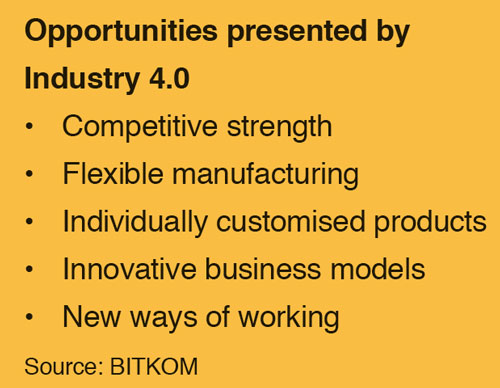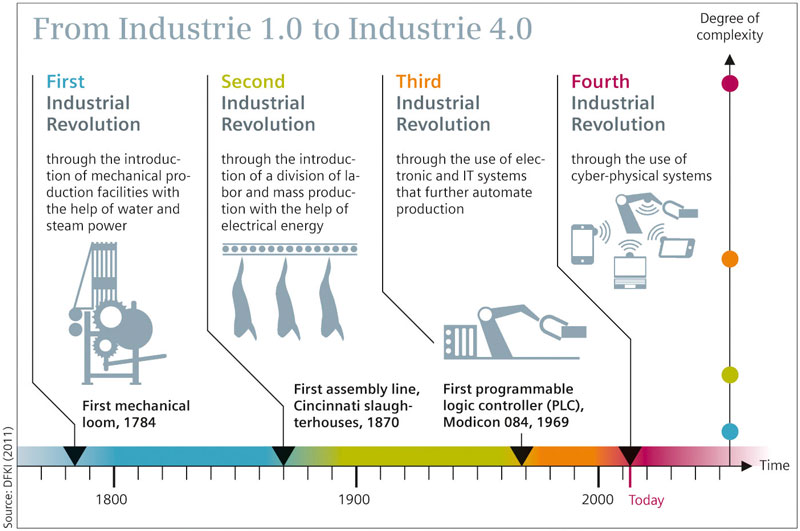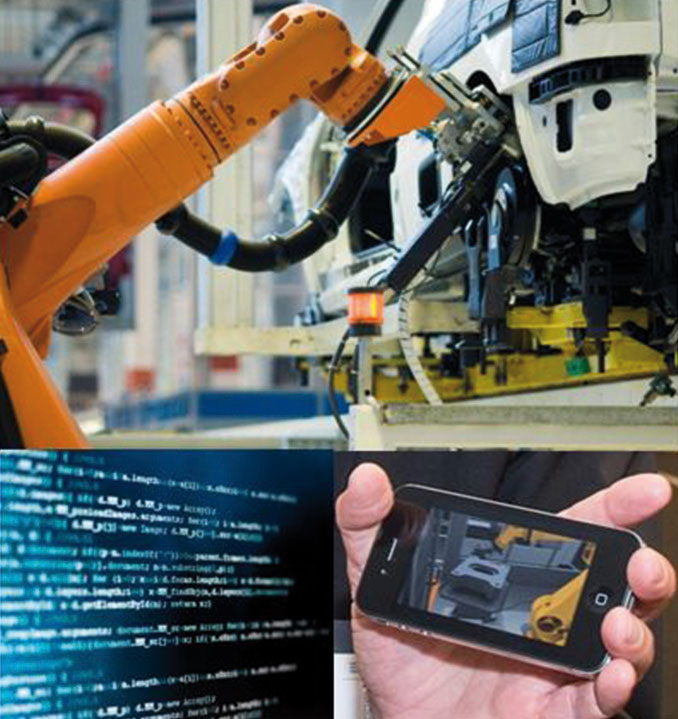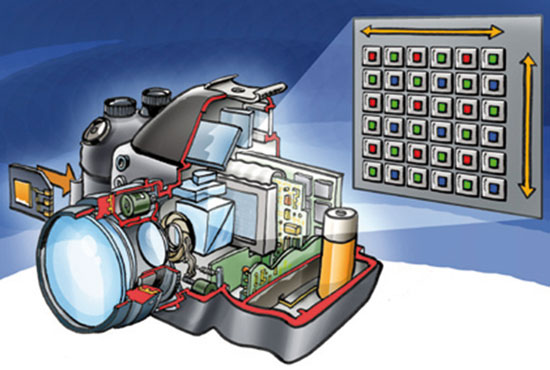Industry 4.0 – Summary report
DLG Expert report 7-2016
Author:
- Leo Bartevyan
IT Systems Engineer, Digital Factory Solutions, CENIT AG*.
Contact:
- Dr.-Ing. Annette Schmelzle, DLG Competence Center Food, A.Schmelzle@DLG.org
In cooperation with the DLG Food Technology Committee.
The German term ‘Industrie 4.0’ was fi rst used at the 2011 Hannover Messe trade fair. It encompasses a whole series of innovative processes and developments that are combining new technologies with industry standards in the manufacturing sector in order to serve increasingly fast-moving markets. The internet has fundamentally changed communication and consumer behaviour. Today, thanks to web and cloud technology, information can be shared around the globe.
Web-based data sets are not restricted to particular devices or software and can be downloaded and modifi ed in an instant, no matter where you are in the world. This new playing fi eld will change the face of industry and manufacturing forever. Industry 4.0 is better defi ned not by its underlying technologies, but by the paradigm shift that is moving us away from centralised control to a world of decentralised, intelligent process units.
Organisation and software, in addition to technology, will have a crucial role in the transition. Information is at the heart of this process. It will control how a product is designed and manufactured. It will play a part throughout the lifecycle of a product and beyond. Information is the basis for continuous improvement; it is the DNA of digital evolution. Industry 4.0 will provide the infrastructure and methods to industry standards. New materials, individually customised products, intelligent products and machines, modular processes, data processing and communication – at its core, Industry 4.0 is about the interaction between the web, the product and the user.
First industrial revolution: machines
In 100 AD, Heron of Alexandria discovered the principle of steam power with his aeolipile. But it took nearly another 1,600 years for steam power to be used in industry. James Watt made the breakthrough in 1769 by combining the technology in existence at the time with a centrifugal governor. This fi rst regulator made the steam engine suitable for industrial applications. It is also an example of a simple cybernetic system. Then, as now, innovative technologies provided the basis. But it was the ability to control the system that made it successful – and that’s still the case today. In 1866 Werner von Siemens transferred the principle of the steam engine to the electricity generator. This breakthrough made energy transportable and paved the way for whole new types of machine that ran on electric motors.
Second industrial revolution: processes
In 1833 in England – in a parallel and largely unnoticed development – the fi rst steps towards industrial mass manufacturing were being made in the production of ship’s biscuits. The meat-packing lines of 1870s Cincinnati inspired the young Henry Ford to introduce the principle of assembly line production to the world of motor cars – which at that time were still being made by hand. The fi rst Ford rolled off the assembly line in 1913 and this new form of organisation took hold around the world. The gap between the discovery of the technology and its application in industry was around 90 years.
Third industrial revolution: electronics
The first flip-flop circuit in 1958 laid the foundation for a huge leap forward in electronics. Just three years later, the fi rst numerical control tool came on the market. By the late 20th century, a networking structure suitable for industrial application had become reality thanks to programmable logic controllers and fieldbus systems. Electronic signals and their processing are the key legacies of this era. It took only 25 years to get from the first circuit board to the SIMATIC industrial automation system. Moore’s law states that the number of transistors in a dense integrated circuit will double approximately every two years, and so far this has proven empirically to be true. In 1973 Kuka Robotics unveiled the first robot with six axes, a move that helped to drive forward automation in Germany and around the world.
Fourth industrial revolution: information
Over the past 50 years, a number of developments have arisen concurrently. In 1970, for example, the US retail chain Walmart introduced the barcode. This printable, machine-readable code enabled it to uniquely identify products and process data. The EAN code then arrived in 1977, followed by other developments that added more and more information to product packaging, using formats that could be read faster and with fewer errors. In the same year, Steve Wozniak and Steve Jobs released the assembly kit for their Apple 1, the first low-cost computer.
The Apple II was an ‘open system’ and on its market launch had eight free slots for adding peripheral devices. This open and expandable architecture drove the success of the personal computers of Apple, Commodore, Tandy and IBM. There was an explosion in video games and software designed for private users. PCs were also suitable for professional applications and for offices. The software became the main success factor.
In 1989 Tim Berners-Lee laid the foundations for hypertext, a new way of presenting information. Using hypertext markup language, or HTML, he created the open system platform that went on to change the world – the world wide web. Today, we think nothing of using the catch-all term ‘internet’ to describe the mind-boggling range of protocols, services and applications, with interactive formats incorporating text, images, music and video. The internet protocol and open standards were the basis for a new form of communication.
Gradually, the devices got quicker and the content more advanced. Computers evolved into laptops, notebooks and later tablets. As mobile networks became more powerful and phones ‘smart’, the internet finally became portable and thereby omnipresent. Today, thanks to web and cloud technology, information can be shared around the globe with a single click or swipe. Information is now independent of particular devices and software and can be accessed instantaneously across the world. This is opening up whole new possibilities for industry. And that is exactly what Industry 4.0 is about. Production and automation stand on the cusp of change, away from central control and towards autonomous objects that are able to communicate with each other, so that information itself is deciding where and how a product is made.
Web 2.0
To this day, Tim Berners-Lee has a problem with the term Web 2.0. He maintains that from the outset, the world wide web was designed so that users could create their own content. The first browser also functioned as an editor, after all. Despite his objections, Web 2.0 has become so widely established as a byword for new and greatly improved technologies that it has now given rise to the term Industry 4.0. At its core, Web 2.0 is about the growing importance of information in the form of content. Users play a key role in how value is added by generating content themselves and making this universally accessible. Wikipedia is a case in point. The name is a portmanteau of wiki, the Hawaiian word for ‘fast’, and encyclopaedia. A wiki is a website that allows anyone with access to a browser to easily edit its pages without the need for any technical expertise.
The freely licensed online encyclopaedia lives from the content provided by its users. Anyone can edit or amend the information it contains. What sounds like a recipe for chaos, works fantastically well in reality and is contributing to a global body of knowledge that is growing all the time. But some rules and conventions are essential if YouTube, Instagram and other such sites are to work. The idea of this netiquette is to keep interactions in check and to serve as a kind of minimum standard (RFC 1855). Anything that it doesn’t cover is usually specified within the terms of use of the websites and social networks/platforms.
Digitisation and digital transformation
These two terms are often used synonymously, however digitisation forms the basis for digital transformation. Taking digital photography as an example, it is possible to track and distinguish between the two processes very clearly. It all began with a light-sensitive data chip towards the end of the 1960s. The resolution was very low and the apparatus required very large and unwieldy. The first portable camera that can be considered a forerunner of the digital camera, developed by Steve Sasson at Kodak in 1975, was thus called a “portable all electronic still camera”. However it remained simply a prototype. It remains an irony of history that the company that first developed digital camera technology had to discontinue production and withdraw from photography completely in 2012. They had failed to recognise the potential of their own development and had not seen the market. With the “Mavica”, Sony launched their own development working on the same principle in 1981 and this is generally held to be the first “consumer digital camera”.
The name “Mavica” (Magnetic Video Camera) refers to the storage system in the form of a magnetic tape. Although the recording was “digital”, digital storage of the data only became reality ten years later. But then everything moved very quickly. A norm for standardised compression of digital images was adopted with JPEG in 1991. This standard was the breakthrough for digital photography!
Suddenly it was possible to compress digital photos in such a way that they could be stored and even sent by e-mail. Step by step an impressive digital transformation then followed. In the year 2000 Sharp launched the first mobile phone with integrated digital camera on the market and in 2007 the iPhone rang in a whole new era of smartphones. It is now no longer possible to imagine everyday life without digital snapshots and videos. Platforms such as Facebook, Twitter, Flickr or Instagram are a new, independent development born of digitisation. Terms such as “Selfie”, “Emoji”, “Likes” or “Followers” bear testimony to a new era and new digital self-realisation. Digital photos and videos, available instantly worldwide, can give pleasure, save human lives, help solve crimes or trigger revolutions. The transformation also created new fields of business and resurrected familiar segments. A company from Oldenburg is now considered to be Europe’s largest supplier of photo books. The physical photo album is back again and very popular, just “digitally transformed”.
IPv6 and the Internet of Things
The IP or ‘internet protocol’ address is a unique number identifying anything that is connected to the internet. It is used to communicate directly with computers and other devices. The existing IP address system is currently running at over 99 per cent capacity. As a result, huge numbers of computers, tablets and smartphones are organised in reserved sub-networks, such as the address block from 192.168.0.0. to 192.168.255.255 for private networks. These addresses can only be communicated with via routers and dynamic IP addresses. Demand is growing, however, not least because webcams, games consoles, TVs and other household appliances also need their own IP addresses. The next-generation IPv6 format (RFC 2460) uses 32 digits, meaning it can support over 340 sextillion IP addresses. That’s 340 followed by 36 zeroes, or around 600 quadrillion addresses for every square millimetre of the Earth’s surface. Hexadecimal notation is used to abbreviate IPv6 addresses, making them much shorter. For example, ‘::1’ – a double colon followed by a one – describes the localhost address, which contains 15 zeroes and a 1 and is the equivalent of the 127.0.0.1 localhost address in the IPv4 format.
Thanks to this new system, any node can now be given its own IP address. Any product, package or computerised object can be communicated with directly via a unique internet address. This means that all the major prerequisites are now in place for the Internet of Things (IoT). In the future, the web won’t be restricted just to computers and smartphones, it will also encompass household objects and the things we interact with in our daily lives.
Virtual stores and private products
In a virtual store, people can buy almost anything they want, right around the clock. They can even order fresh food to be packed up ready for them to collect or to be delivered to their door. Perhaps this will soon be delivered by drones. And the products, too, will become more individualised. Consumer behaviour is changing. Made-to-order lifestyle products need new and flexible production processes. Even today, people are custom mixing their own muesli or ordering birthday beer with personalised labels. This calls for organisational and technological changes in manufacturing.
Embedded systems and cyber-physical systems
Control systems can autonomously operate manufacturing equipment within clearly defined parameters, in order, say, to keep fermentation processes within a specified temperature range. Microchips are directly integrated into plant and machinery because they simplify the management of complex processes, or indeed make it possible to manage them at all, creating what are known as embedded systems. The transition to the cyber-physical system (CPS) is fluid, because the lines between the virtual, digital and real worlds are disappearing before our very eyes. A CPS responds to changes; it can digitally process tasks in a split second and it can convert input into commands. Pacemakers, ABS and ESP are examples of cyber-physical systems that are now an indispensable part of our day-to-day lives.
Everything is getting smart
Smart grid, smart objects and the smart factory are examples of the paradigm shift being brought about by these new developments. Cybernetics, in the form of the centrifugal governor, introduced a basic form of automatic control to the steam engine, ushering in a new industrial age. And now, intelligent technology is available that can autonomously control even the most complex processes: self-regulating networks, objects that can make their own way around and factories that are partially automated. This might sound crazy at first, but only as crazy as an encyclopaedia that anyone can contribute to. And therein lies its key strength.
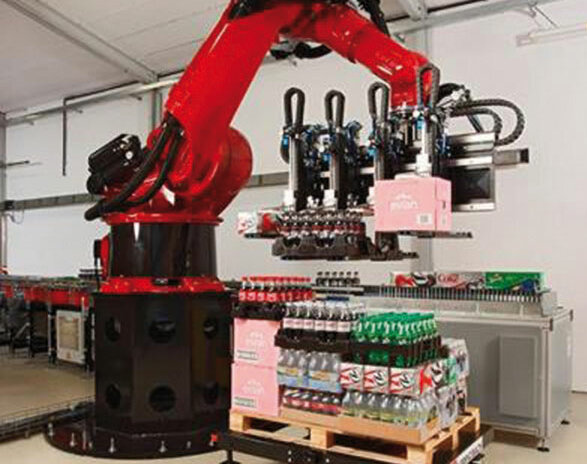
adapts, autonomous vehicle delivers the shipping pallet to the loading dock ready for dispatch
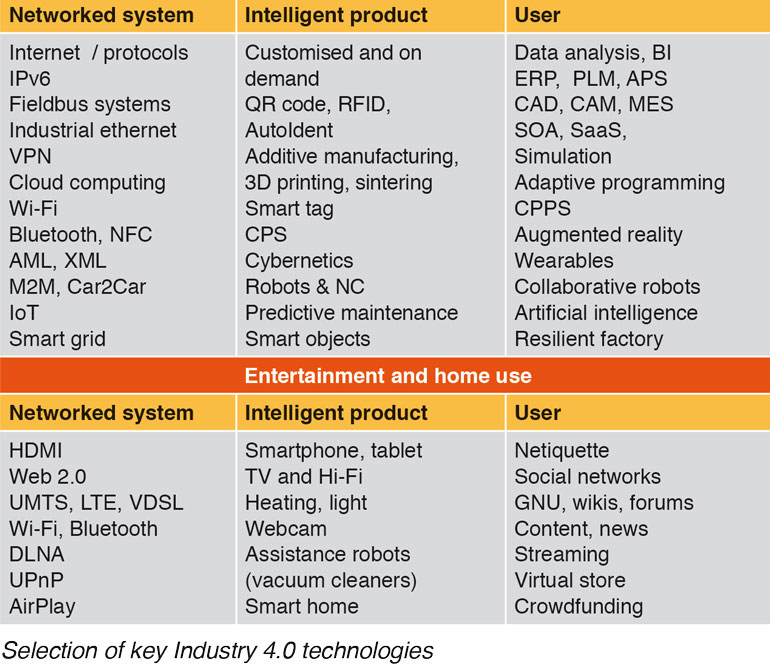
The resilient factory
A decentralised, self-organising system will not necessarily be better or more productive than a traditional mass production system that has been optimised to the fullest extent possible. In standard operation, an autonomous system may even need more transport units than one that is based on a materials purchasing system, and it may take longer to complete an order. But autonomous systems are far more fl exible and have much greater redundancy, so they clearly come out on top when taking a long-term view because of natural fl uctuations in demand. A decentralised, self-organising system can respond independently and adeptly to unexpected events. The result is the resilient factory – one that is error-tolerant, agile and able to learn.
Advanced manufacturing
The term ‘advanced manufacturing’, used in the US to describe the transition, has a somewhat broader meaning that also incorporates trends and technologies in consumer electronics. There too, the market is on the cusp of huge change. TVs, games consoles and the internet are beginning to merge. Streaming and video portals are transforming markets. Consumers, too, are changing their media behaviour and are increasingly becoming authors themselves. Google’s takeover of a robot manufacturer and a leading maker of thermostats and smoke alarms demonstrates that the automation of the household and of production have common roots, with information as the key to success.
New standards
The following application areas are the current norm:
- PLM (product lifecycle management)
- ERP (enterprise resource planning)
- Digital factory (planning and simulation of production)
- MES (manufacturing execution systems)
- SCADA/SPS/CNC for machinery control at signal level
This separation of functions is not conducive to autonomous, flexible production. Instead there should be a top-down orchestration (vertical approach) that paves the way for cyber-physical production systems (CPPS). This involves the setting up and networking of individual software services into a pure business process. A company’s APO, OEE, AutoID, RFID, OLP or CIM functions can be integrated internally into leading EPR systems or covered by external services. This could make use of AutomationML (Automation Markup Language), a universal format designed to be compatible with all types of engineering data, from topology, 3D geometry and kinematics to processes and logical dependencies. The idea of AML (IEC62714) is to provide a comprehensive, open and XML-based standard language for data relating to plant engineering, manufacturing and production, and process-based industries.
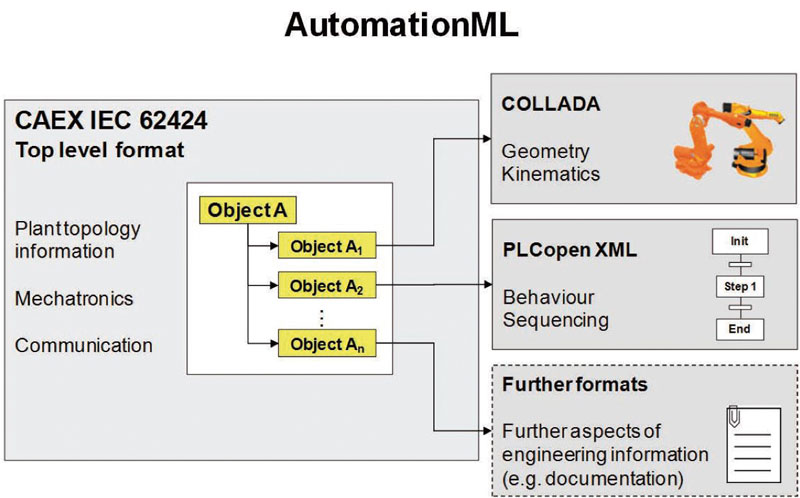
Tool-free production: laser sintering and selective laser melting
The package that you can track by smartphone is already a reality. In the near future, we might be downloading our products from a virtual store – just as we do today with apps – and then simply printing them on a 3D printer. There are already various market-ready 3D printing techniques that are already being used for modelling or for building prototypes. Laser sintering works by melting and setting a powdered material layer by layer. Excess powder is blown away and can be re-used. The creation of mould forms is increasingly being replaced by rapid prototyping techniques where items are manufactured directly from the relevant material. In the case of selective laser melting, the temperature of the sintering process is so high that it allows even the hardest of metals such as titanium to be melted.
Additive manufacturing
Thanks to base materials or ‘filaments’ that can be washed away or blown away, it is already possible to print out complex mechanical modules that would usually have to be assembled. This could revolutionise industrial supply chains. Spare parts for a machine would no longer have to be sent halfway around the world, but could simply be printed out there and then. Consumer goods could be produced ‘on demand’, saving storage costs and reducing the risk of sitting on excess inventories. As well as plastic and carbon, parts can today be printed using steel, titanium and other metals. And that includes fully functional modules that include articulations and moving parts. In the Industry 4.0 era, it will be possible to flexibly combine additive manufacturing with other processes, creating whole new kinds of production methods. An example would be a mix of additive manufacturing, injection-moulding and human-robot cooperation. 3D printing has arrived in industrial fabrication. In its status report on additive manufacturing methods, the Association of German Engineers (VDI) takes a close look at these topics and explores matters relating to product and patent law and to responsibility for software and liability issues.
Safety and security
The more the internet and its smart objects make inroads into our daily lives and our production systems, the more important it will be to think about security and safety standards. But this is about much more than netiquette. After all, there’s a world of difference between an app crashing on your smartphone and a reactor cooling system failing. BITKOM, the Federal Association for Information Technology, Telecommunications and New Media, makes the following distinction between safety and security. “In addition to operational safety, which dictates that production systems and products should not pose a danger to people or the environment, a second aspect is becoming hugely important – that of security from attack. Plant and products as well as data and know-how have to be reliably protected from unauthorised access and misuse.” The cases of Stuxnet, Duqu and Flame have shown that malware can even penetrate control systems. This is where the US approach differs from Industry 4.0. In Germany, operational safety at machine and fieldbus level is high on the agenda and there is a lot of potential in this area, while the top solutions for traditional IT and operating systems are emerging from the US. The move towards cyber-physical production systems is occurring from different starting positions and presents an opportunity to use expertise in production and automation processes as a competitive advantage.
Security by design
For Industry 4.0, BITKOM recommends that security should play an active part in the development of systems, starting with the design stage: “It is not enough to simply bolt on security functions after incidents have taken place. It has to be taken into account from the outset – security by design. Furthermore, the increasing extent of connectedness and cooperation requires the various partners involved to have a high degree of trust in each other. The onus is on the IT security industry to provide reliable concepts, architectures and standards that can provide a foundation for trust. Manufacturers and operators must be sure that their know-how, their intellectual property and their data are protected. The challenge lies in equipping existing factories for these new requirements and at the same time coming up with solutions for new factories.”
Summary
We do not need to wait for Industry 4.0. We are already in the midst of it. Its key technologies are in use today. Certain sectors are already using these advanced technologies on an industrial scale. Definitive standards will be the critical factor in their universal application. Information will shape the product. In Industry 4.0, more than ever before, it is the key to success. Germany is well placed to take a leading role in the provision and implementation of Industry 4.0 solutions. The central government and federal states have launched strategic initiatives to drive its development. BITKOM, the VDI and the German Engineering Federation (VDMA) have put together practical recommendations for action that are freely available to download. With the financial and institutional support of companies, Germany is excellently positioned, but it is not alone. The USA and Asia have agreed billion-dollar investment packages. The battle for the markets of Industry 4.0 has already begun.
Additional sources and documents that are available to download:
- ‘VDE-Trendreport 32 - 2013’ (Trend Report 32-13, 2013, published by the Association for Electrical, Electronic & Information Tech-nologies) http:// www.vde.com/de/Verband/Pressecenter/Pressemeldungen/Fach-und-Wirtschaftspresse/2013/Seiten/32-2013.aspx
- VDI/VDE Society for Measurement and Automatic Control (GMA): Cyber-Physical Systems: Chancen und Nutzen aus Sicht der Au-tomation (Cyber-Physical Systems: Opportunities And Benefits From The Perspective Of Automation) www.vdi.de/fileadmin/vdi_de/redakteur_dateien/ gma_dateien/Stellungnahme_CPS_2013-03-28_final.pdf
- BITKOM: Umsetzungsempfehlungen für das Zukunftsprojekt Industrie 4.0 (Implementation recommendations for the Industry 4.0 future project) www.plattform-i40.de/sites/default/files/Abschlussbericht_Industrie4%200_barrierefrei.pdf
- Wikipedia, the free encyclopaedia: PLM, Apple I, Apple II, Personal Computer, Internet, Netiquette, IoT
- VDI-Statusreport Additive Fertigungsverfahren, September 2014 (Association of German Engineers (VDI), Status Report on Additive Manufacturing Methods, September 2014), www.vdi.de/fileadmin/vdi_de/redakteur_dateien/gpl_dateien/VDI_Statusreport_AM_2014_WEB.pdf
- AutomationML verbindet Werkzeuge der Fertigungsplanung (white paper, AutomationML connects tools in production planning) www.automationml.org/o.red/uploads/dateien/1314344567-automationml_whitepaper.pdf
- Bild 3: Peter Wellemann,https://commons.wikimedia.org/wiki/File%3AChipincamera.jpg
*CENIT is a leading consultancy and software specialist. For more than 25 years, it has been working with companies to optimise business processes in the fields of digital factory implementation, product lifecycle management (PLM), SAP PLM, enterprise information management (EIM), business optimisation & analytics (BOA) and application management services (AMS). CENIT’s established, proprietary software complements the standard solutions provided by strategic partners such as DASSAULT SYSTEMES, SAP and IBM. Its solutions include the FASTSUITE product family for the digital factory, cenitCONNECT for SAP PLM-related processes, the cenitSPIN PLM desktop tool and the CENIT ECLISO information management system. The company employs around 700 people around the world. Its customers are companies in the automotive, aerospace and engineering industries, in the tool- and mould-making sector, in financial services, in retail and in consumer goods.
Contact:
Dr.-Ing. Annette Schmelzle, DLG Competence Center Food, A.Schmelzle@DLG.org
In cooperation with the DLG Food Technology Committee.


